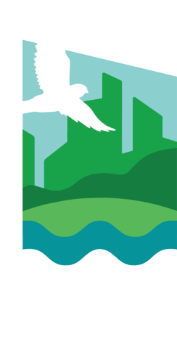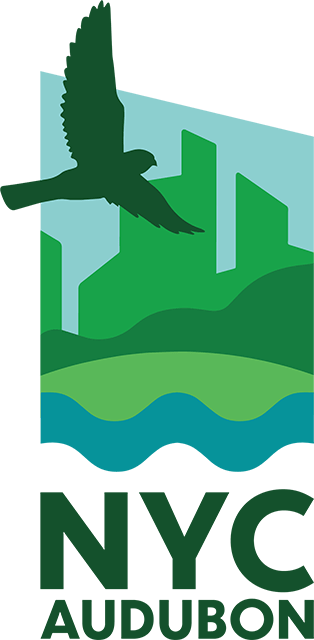Waterbirds of NY Harbor
NYC Audubon has a 40-year history of protecting the wading birds, shorebirds, and waterfowl that depend on New York City’s wetland and coastal habitats. Our rich and recovering harbor is home to an incredible diversity of these waterbirds: wild islands host nesting egrets, herons, and ibis, while sandy beaches and marshes provide both breeding and migratory foraging grounds for endangered waterbirds like terns, skimmers, and sandpipers. Because waterbirds are sensitive to environmental change, they are excellent indicators of the health of the larger ecosystem. As the only organization in New York City dedicated to protecting wild birds, NYC Audubon is in a unique position to study these local populations—and use the knowledge gleaned for the protection, restoration, and management of our waterbirds and their habitats.
NYC Audubon’s scientific staff conducts field research and manages an extensive volunteer community science program, in collaboration with academic research partners, to gather data on the health and reproductive success of key waterbird species and habitats:
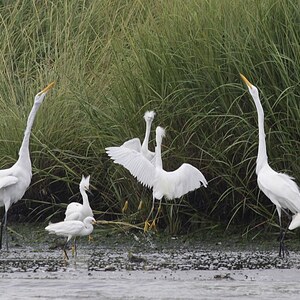
Great and Snowy Egrets display during breeding season in the Jamaica Bay Wildlife Refuge, Queens. Photo: Don Riepe
Harbor Herons
New York City, one of the world’s great metropolises known for its bustling culture and skyscrapers, is also home to a hidden wilderness: the Harbor Heron islands. These protected wildlife sanctuaries right in our midst provide safe nesting grounds for Great and Snowy Egrets, Black- and Yellow-crowned Night-Herons, Glossy Ibis, and Little Blue and Tricolored Herons. For over 35 years, NYC Audubon has monitored and advocated for the protection of these birds and their nesting and foraging habitat.
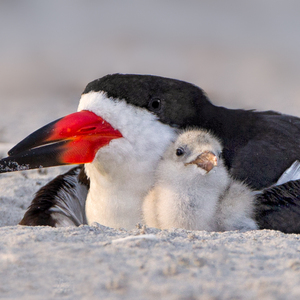
Black Skimmers nest on several beaches on the Rockaway Peninsula, in Queens. Photo: David Speiser
Beach Nesting Birds
Each year, from April through August, thousands of birds nest on the bare sands of New York City beaches and inlets. Common and Least Terns, Black Skimmers, American Oystercatchers, and Piping Plovers—all of these species come to our city beaches to breed, as they have for millennia. The birds lay their eggs in shallow scrapes in the sand, sometimes lined with bits of shell and debris, placed above the high tide line in open, sandy areas with little to no vegetation. The eggs and chicks are perfectly camouflaged to match their sandy environment. Downy chicks that look like tiny fluff balls leave their nests soon after hatching—but stay on the beach for several weeks, learning from their parents, until they are old enough to fly and survive on their own.
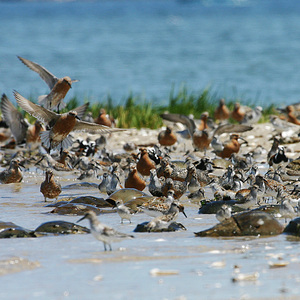
Migrating shorebirds including Red Knots, Semipalmated Sandpipers, Dunlin, and Ruddy Turnstones feed among spawning horseshoe crabs in Jamaica Bay. Photo: Don Riepe
Migratory Shorebirds
Each spring and late summer, New York City is visited by the “great champions” of bird migration: the shorebirds. The Red Knot flies as far as 9,300 miles each spring and fall, between wintering grounds in Tierra del Fuego and nesting territory above the Arctic Circle. Along the way, it and other shorebird species such as Semipalmated Sandpipers, Sanderlings, Dunlin, and Ruddy Turnstones depend on stopping and refueling in New York City’s marshes and on our beaches and mudflats.
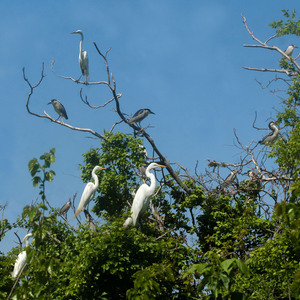
The Hoffman Island nesting colony includes Great and Snowy Egrets and Black-crowned Night-Herons, seen above, as well as Glossy Ibis, Double-crested Cormorants, and Great Black-backed and Herring Gulls. Photo: NYC Audubon
Get to Know the Harbor Herons!
Over the almost 40 years since wading birds were first discovered nesting on several islands west and north of Staten Island in the early 1980s.
